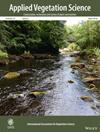Assessment of habitat connectivity in a highly fragmented ecosystem: The seasonal tropical dry forest in Ecuador
Abstract
Context
Connectivity is a parameter that plays a fundamental role in highly fragmented ecosystems, such as the seasonal tropical dry forest.
Objectives
The objective of this research is to calculate the evolution of fragmentation and the functional connectivity of the Ecuadorian seasonal dry forest from 1990 to 2018, and to compare the Ecuadorian state's reforestation plan with our reforestation plan, which is based on maximising connectivity with the smallest possible reforested area.
Methods
The land cover changes, fragmentation and functional connectivity, measured by employing cumulative cost analyses at three different distances (0.5, 5 and 10 km), that occurred in Ecuadorian seasonal dry forests between 1990 and 2018 were verified using GIS environments, vector layers and Graphab software. A reforestation plan was also developed using various connectivity metrics and was then compared with that proposed by the Ecuadorian Ministry of the Environment.
Results
Between 1990 and 2018, 2647 km2 of dry forest was lost in the study area. Former forest areas were put mainly to agricultural uses, which increased by 12.96%. The total number of patches decreased from 6908 to 5357, signifying a loss of 30% of the forest area and leading to losses of up to 75% of connectivity. Areas with low connectivity and a risk of disappearance were identified, and a new reforestation plan was proposed, which was based on maximising connectivity with small patches.
Conclusions
Because of the fragmentation, the connectivity of the seasonal dry forest in Ecuador is dramatically decreasing in the last decades. Therefore, the reforestation plans should prioritise areas whose reforestation increases habitat functional connectivity, which could provide more benefits than increasing the forest area without considering the global connectivity.


 求助内容:
求助内容: 应助结果提醒方式:
应助结果提醒方式:


